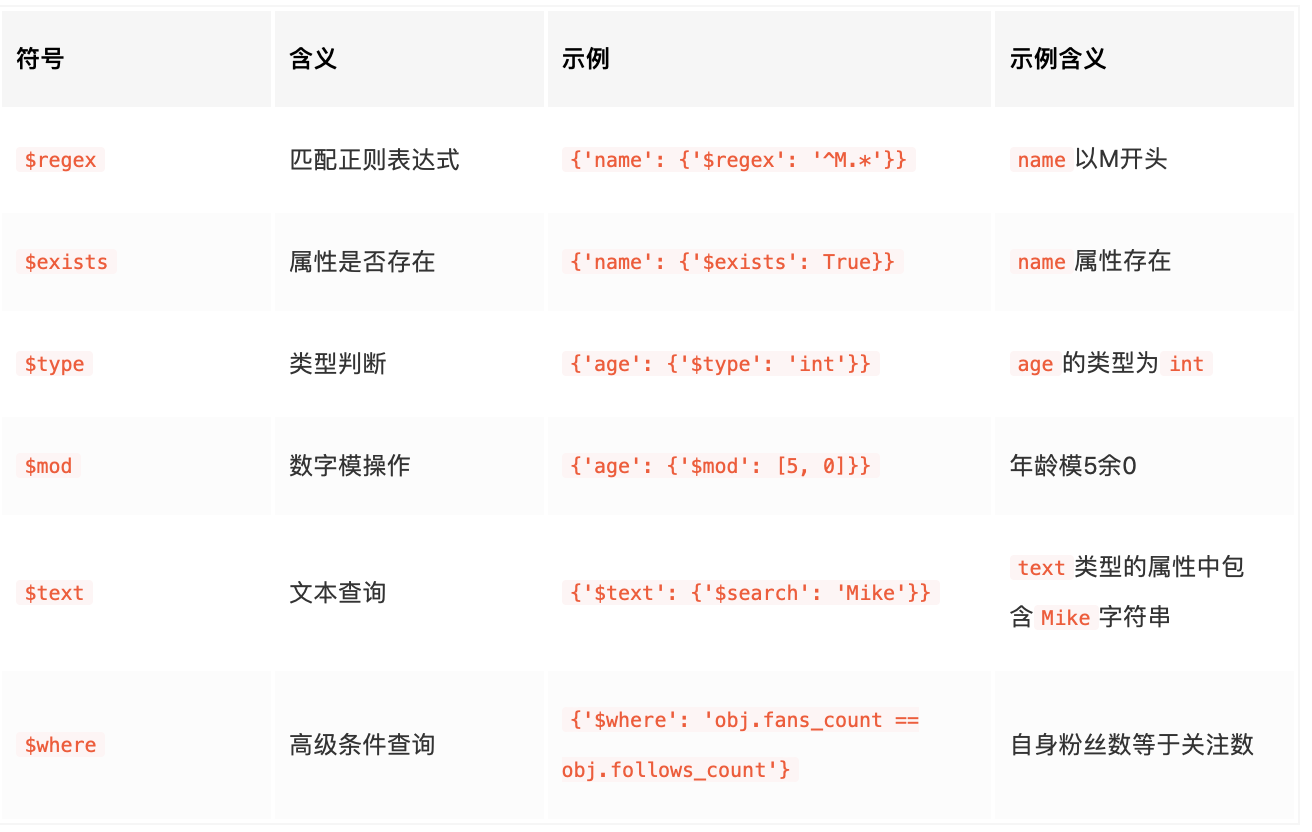转载:https://juejin.im/post/5addbd0e518825671f2f62ee
MongoDB是由C++语言编写的非关系型数据库,是一个基于分布式文件存储的开源数据库系统,其内容存储形式类似JSON对象,它的字段值可以包含其他文档、数组及文档数组,非常灵活。
1. 连接mongo
import pymongo client = pymongo.MongoClient(host='localhost', port=27017)
或者
client = MongoClient('mongodb://localhost:27017/')
指定用户名+密码
client = MongoClient('mongodb://user:password@localhost:27017)
2. 指定数据库
db = client.test
or
db = client['test']
3. 指定集合
collection = db.test1
or
collection = db['test1']
4. 新增数据
# 添加单条 student = { 'id': '20170101', 'name': 'Jordan', 'age': 20, 'gender': 'male' } result = collection.insert_one(student) print(result) print(result.inserted_id)
在MongoDB中,每条数据其实都有一个_id属性来唯一标识。如果没有显式指明该属性,MongoDB会自动产生一个ObjectId类型的_id属性。insert()方法会在执行后返回_id值
# 添加多条 student1 = { 'id': '20170101', 'name': 'Jordan', 'age': 20, 'gender': 'male' } student2 = { 'id': '20170202', 'name': 'Mike', 'age': 21, 'gender': 'male' } result = collection.insert_many([student1, student2]) print(result) print(result.inserted_ids) 该方法返回的类型是InsertManyResult,调用inserted_ids属性可以获取插入数据的_id列表。
5. 查询数据
# 查询单条 result = collection.find_one({'name': 'Mike'}) print(type(result)) print(result) # _id 查询 from bson.objectid import ObjectId result = collection.find_one({'_id': ObjectId('593278c115c2602667ec6bae')}) print(result) 查询的结果存在则为字典,如果查询结果不存在,则会返回None
# 查询多条 results = collection.find({'age': 20}) print(results) for result in results: print(result) 返回结果是Cursor类型,它相当于一个生成器,我们需要遍历取到所有的结果,其中每个结果都是字典类型。
更多复杂查询条件:
#查询年龄大于20的用户
results = collection.find({'age': {'$gt': 20}})

# 查询名字以M开头的数据 results = collection.find({'name': {'$regex': '^M.*'}})

6. 计数
count = collection.find().count()
print(count)
现在已经不推荐使用count了,可以使用document_count(). 用法和count是一样的
7. 排序
results = collection.find().sort('name', pymongo.ASCENDING) print([result['name'] for result in results]) 这里我们调用pymongo.ASCENDING指定升序。如果要降序排列,可以传入pymongo.DESCENDING
8. 偏移
# 利用skip()方法偏移几个位置,比如偏移2,就忽略前两个元素,得到第三个及以后的元素 results = collection.find().sort('name', pymongo.ASCENDING).skip(2) print([result['name'] for result in results]) # 还可以用limit()方法指定要取的结果个数 results = collection.find().sort('name', pymongo.ASCENDING).skip(2).limit(2) print([result['name'] for result in results]) # 值得注意的是,在数据库数量非常庞大的时候,如千万、亿级别,最好不要使用大的偏移量来查询数据,因为这样很可能导致内存溢出。此时可以使用类似如下操作来查询: from bson.objectid import ObjectId collection.find({'_id': {'$gt': ObjectId('593278c815c2602678bb2b8d')}}) 这时需要记录好上次查询的_id
9. 更新数据
#对于数据更新,我们可以使用update()方法,指定更新的条件和更新后的数据即可 condition = {'name': 'Kevin'} student = collection.find_one(condition) student['age'] = 25 result = collection.update(condition, student) print(result) 这里我们要更新name为Kevin的数据的年龄:首先指定查询条件,然后将数据查询出来,修改年龄后调用update()方法将原条件和修改后的数据传入。 {'ok': 1, 'nModified': 1, 'n': 1, 'updatedExisting': True} 返回结果是字典形式,ok代表执行成功,nModified代表影响的数据条数。 我们也可以使用$set操作符对数据进行更新 result = collection.update(condition, {'$set': student}) 这样可以只更新student字典内存在的字段。如果原先还有其他字段,则不会更新,也不会删除。而如果不用$set的话,则会把之前的数据全部用student字典替换;如果原本存在其他字段,则会被删除。
另外,update()方法其实也是官方不推荐使用的方法。这里也分为update_one()方法和update_many()方法,用法更加严格,它们的第二个参数需要使用$类型操作符作为字典的键名,示例如下: condition = {'name': 'Kevin'} student = collection.find_one(condition) student['age'] = 26 result = collection.update_one(condition, {'$set': student}) print(result) print(result.matched_count, result.modified_count) 这里调用了update_one()方法,第二个参数不能再直接传入修改后的字典,而是需要使用{'$set': student}这样的形式,其返回结果是UpdateResult类型。然后分别调用matched_count和modified_count属性,可以获得匹配的数据条数和影响的数据条数。 condition = {'age': {'$gt': 20}} result = collection.update_one(condition, {'$inc': {'age': 1}}) print(result) print(result.matched_count, result.modified_count) 这里指定查询条件为年龄大于20,然后更新条件为{'$inc': {'age': 1}},也就是年龄加1,执行之后会将第一条符合条件的数据年龄加1。 如果调用update_many()方法,则会将所有符合条件的数据都更新,示例如下: condition = {'age': {'$gt': 20}} result = collection.update_many(condition, {'$inc': {'age': 1}}) print(result) print(result.matched_count, result.modified_count)
10. 删除数据
删除操作比较简单,直接调用remove()方法指定删除的条件即可,此时符合条件的所有数据均会被删除。示例如下: result = collection.remove({'name': 'Kevin'}) print(result) 另外,这里依然存在两个新的推荐方法——delete_one()和delete_many() result = collection.delete_one({'name': 'Kevin'}) print(result) print(result.deleted_count) result = collection.delete_many({'age': {'$lt': 25}}) print(result.deleted_count) delete_one()即删除第一条符合条件的数据,delete_many()即删除所有符合条件的数据。它们的返回结果都是DeleteResult类型,可以调用deleted_count属性获取删除的数据条数。
删除集合
collection.drop()
其他操作:
另外,PyMongo还提供了一些组合方法,如find_one_and_delete()、find_one_and_replace()和find_one_and_update(),它们是查找后删除、替换和更新操作,其用法与上述方法基本一致。
另外,还可以对索引进行操作,相关方法有create_index()、create_indexes()和drop_index()等。
关于PyMongo的详细用法,可以参见官方文档:http://api.mongodb.com/python/current/api/pymongo/collection.html。
另外,还有对数据库和集合本身等的一些操作,这里不再一一讲解,可以参见官方文档:http://api.mongodb.com/python/current/api/pymongo/。